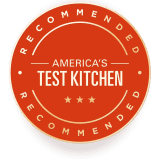The Best Measuring Spoons
Equipment Review
Many versions of this simple tool are surprisingly flawed: drippy, hard to read, or inaccurate. Which models are reliable?
Published June 25, 2019. Appears in Cook's Country TV Season 13: Herbaceous Chicken and Potatoes

We value versatility, but some kitchen equipment can't do double duty. For the utmost precision—and the best results in the kitchen—you need two kinds of measuring cups. For flour, sugar, beans, grains, and other foods that can be scooped up and leveled off, dry measuring cups are best. But using dry measuring cups for liquids won't work. It's difficult to see the liquid inside the cups and easy to overfill them, which makes for both messy and imprecise measuring. For everything from buttermilk to broth, we use liquid measuring cups.
To find the best liquid measuring cup, we focused on models with a 1-cup capacity, the smallest size most companies make, sold individually or in sets. It's essential that 1-cup liquid measuring cups have markings for ¼, ⅓, ½, ⅔, ¾, and 1 cup, so we nixed models that lacked one or more of those increments. We purchased 10 measuring cups priced from about $5 to about $35. About half were traditional glass or plastic cups with handles. Two were made from silicone, which manufacturers claim stays comfortably cool even after microwaving. Two had innovative measurement markings set on an angled ridge inside the cups, designed to be read from above. Another model was a nesting set that looked like lab beakers. It was time to start testing.
Did you know that there's a right way to use a traditional liquid measuring cup? Here's how you should do it: Place the cup on a level surface and slowly pour in the liquid until it reaches the measurement marking, bending briefly to check it at eye level and adjusting as necessary. The surface of the liquid will curve downward slightly (this curve is called a meniscus). The trick for an accurate measurement is to line up the bottom of the curve with the desired marking.
To assess the accuracy of each cup, we used a lab-grade scale to weigh water at six essential measurements—¼, ⅓, ¼, ⅔, ¾, and 1 cup. We then poured the water into the cups and compared the water level to the measurement markings. We repeated this test with the ounce and milliliter markings on each cup. About half the models we tested were either spot-on or off by just a few drops. On the worst models, the 1-cup markings were off by a full tablespoon, enough to negatively affect a recipe.
The two innovative cups each had two sets of measurement markings, one outside, like usual, and another inside, positioned facing upward, so users don't have to crouch to read the markings. One of the innovative cups wasn't reliable; the markings on the outside of the cup were accurate, but the ones inside were not. Fortunately, the other innovative model's two sets of marki...

The mission of America’s Test Kitchen Reviews is to find the best equipment and ingredients for the home cook through rigorous, hands-on testing. We stand behind our winners so much that we even put our seal of approval on them.

Kate is a deputy editor for ATK Reviews. She's a culinary school graduate and former line cook and cheesemonger.
This is a members' feature.
0 Comments